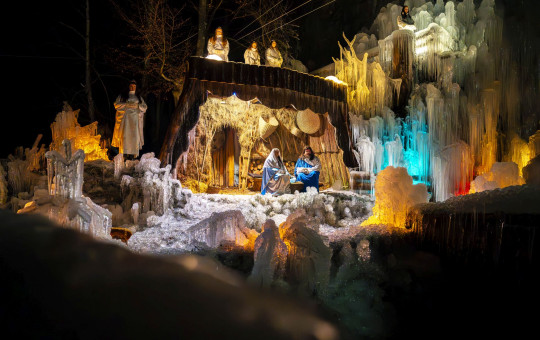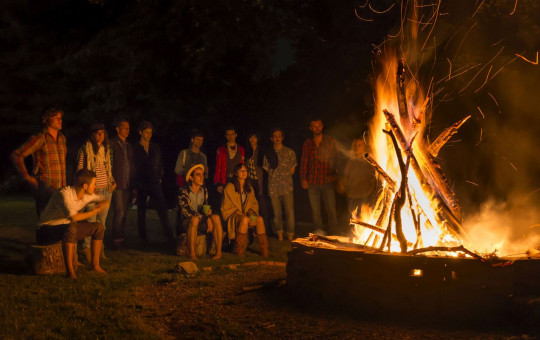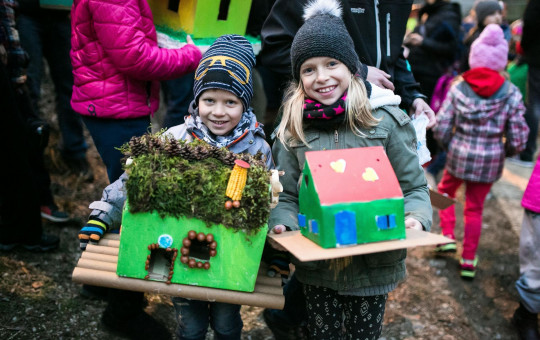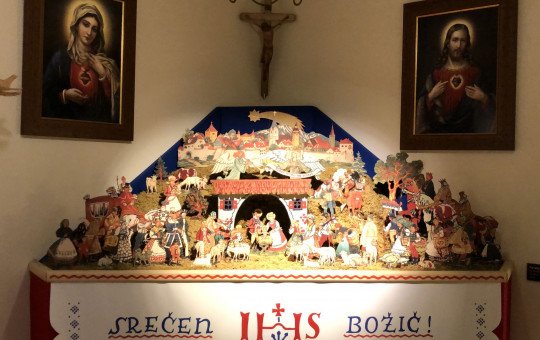Date: 15. February 2020
Time to read: 4 min
Shrovetide Carnival is one of the oldest folk traditions originating from the time before Christianity. In Slovenia, Shrovetide Carnival was first mentioned in the 17th century. Our ancestors believed that the ritual would chase evil spirits from the land.Shrovetide used to be celebrated in a much simpler way. People used to make their carnival masks from materials that were available at home. Children often dressed up as adults, covered their faces in soot and walked from house to house to show themselves to their neighbours.
Different places in Slovenia still have different traditions. The best-known Shrovetide figures include kurenti, laufarji, škoromati, otepovci, orači and zeleni Jurij or Green George.
Ptuj, home of the kurent carnival figure, is famous for the largest and longest celebration. The Cerknica Carnival is also widely known. On Shrovetide, hopping kurent carnival figures chase winter from the land.
A mosaic of Shrovetide colours and figures
In addition to kurent carnival figures, the laufarji from Cerkno are also a traditional Slovenian mask. They wear wooden masks and run through the streets of Cerkno. The Cerknica Carnival is also reigned by Ursula the Witch alongside Jezerko the Lake Man, the Giant Pike Fish, the Dragon, Liza the Witch and Butalci.
Škoromati are the oldest Shrovetide masks in Slovenia. On Shrove Saturday, you can find them in the villages of the southern slopes of the Brkini Hills and the Podgrajsko-Matarsko Plain, where they go on a poberija – door-to-door rounds collecting gifts from people’s homes. They wear bells and traditional colourful hats made of flowers and ribbons.
Another traditional Slovenian carnival mask is orači from Okič in the heart of Haloze.
The carnival character of a woman carrying a man in a basket on her back is also a frequent element of the Slovenian carnival tradition that appears mainly around Ilirska Bistrica, in Brkini together with škoromati and in Haloze.
It is a masterfully crafted mask, where a man carries the basket and the woman who carries him is actually another mask. The character originates from an anecdote where men get drunk on payday and their wives have to carry them home in a basket because they cannot walk.
Green George is a man in an ivy or flowery disguise that is supposed to bring growth and fertility to the field. The regions of Koroška, Štajerska and Bela krajina have kept the tradition of Green George going door-to-door.
The traditional Bohinj carnival masks Otepovci are made from simple cloth and give an impression of decomposing corpse faces in the torchlight.
Camels, gambela, kamelce, kožuta, rüsa – are the heads of Shrovetide animals in which the boys from the Dolenjska and Štajerska regions still disguise themselves to this day.
Börovo gostűvanje (the Pine Tree Feast) is one of our traditional Shrovetide carnivals in which the most masks perform. This old folk tradition originates from Goričko and Ravensko in the Prekmurje region. If no one gets married during Shrovetide, they have to hold a börovo gostüvanje, during which the oldest single boy or girl marries a pine tree. The whole village takes part in throwing a real wedding.
Other important masks include the father and the mother of the pine tree, trumpeters, the chief and the gypsies. Korants and their company are the traditional Styrian mask characterised by an anthropomorphic figure with horns and wings wearing bells. Chicks and bears are also characteristic masks of the Styria region. A frequent Slovenian mask is also a gypsy couple.
Shrovetide masks that no longer exist
One of the characters that no longer exist is Rabolj, who represented winter and fought against Green George but always lost.
Today, its successor is probably the bear that accompanies the kurents across the plain of Ptuj.
Similarly, the character of brna has died out; it impersonated a horse, a donkey or a goat with a beak on its head. A very rare character is also the female daemon Pehtra, once known across all of western Slovenia. Today, it is only seen in the Ziljska dolina and in Podkoren. It is also known as an evil healer character from the children's film Kekec.
-
 Little princesses Photo: Anže Malovrh/STA
Little princesses Photo: Anže Malovrh/STA
-
 Important historical people Photo: Anže Malovrh/STA
Important historical people Photo: Anže Malovrh/STA
-
 Ski fans Photo: Bojan Šuštar
Ski fans Photo: Bojan Šuštar
-
 Pink cats or dogs? Photo: Bor Slana/STA
Pink cats or dogs? Photo: Bor Slana/STA
-
 Pedenjped Photo: Bor Slana/STA
Pedenjped Photo: Bor Slana/STA
-
 Sweet mouse Photo: Bor Slana/STA
Sweet mouse Photo: Bor Slana/STA
-
 Tiger mum and her child. Photo: Daniel Novakovič/STA
Tiger mum and her child. Photo: Daniel Novakovič/STA
-
 Pokači Photo: Daniel Novakovič/STA
Pokači Photo: Daniel Novakovič/STA
-
 Go go Pinkies Photo: Daniel Novakovič/STA
Go go Pinkies Photo: Daniel Novakovič/STA
-
 Child with a trumpet Photo: Gregor Mlakar/STA
Child with a trumpet Photo: Gregor Mlakar/STA
-
 Mad man Photo: Gregor Mlakar/STA
Mad man Photo: Gregor Mlakar/STA
-
 Poor farmers Photo: Gregor Mlakar/STA
Poor farmers Photo: Gregor Mlakar/STA
-
 Woman and her drunk husband. Photo: Martina Kolenc/STA
Woman and her drunk husband. Photo: Martina Kolenc/STA
-
 Laufar Photo: Rosana Rijavec/STA
Laufar Photo: Rosana Rijavec/STA
-
 Ugly man Photo: Martina Kolenc/STA
Ugly man Photo: Martina Kolenc/STA
Greasy fingers on Shrovetide
Homemakers used to make homemade fried-dough fritters and doughnuts without jam fried in lard.
The table was usually also laden with pork and other greasy food. Doughnuts are considered a traditional Shrovetide dessert, similarly to potica on Christmas.
Slovenian homemakers often make another traditional fried pastry called flancati, which can be crumbly or leavened or even both. On Shrovetide, having greasy fingers, being cheerful and frolicking around is a must. This is the time to visit Ptuj, Cerknica, Brda, Bela krajina or another beautiful Slovenian place, you will not be disappointed. You will have the opportunity to enjoy Shrovetide cuisine and dance with a carnival figure.























